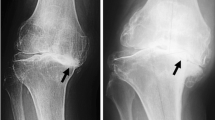Abstract
The objective was to evaluate the efficacy of xenografts to improve the outcomes in elderly patients with tibial plateau fractures. Nineteen cases with a mean age of 74 years were followed prospectively from 1998 to 2003. Six patients each belonged to Schatzker types III, IV and V and one patient belonged to type II. Open reduction with fixation and xenograft impaction was carried out. Clinical and radiological union was assessed including infection rate, incorporation of the xenograft and average collapse of the fracture. The average union time was 20 weeks. No patient had wound infection and all had excellent incorporation of the xenograft with union. The average collapse was 4 mm on follow-up. This series shows the use of only an xenograft in acute fixation of these fractures with favourable outcome. Furthermore, it reduces operative time, bleeding and associated co-morbidities, which is of more significance in an elderly age group.
Résumé
évaluer l’efficacité des xénogreffes chez les patients âgés dans le cadre des fractures du plateau tibial. 19 cas, d’âge moyen de 74 ans ont été suivis et traités de façon prospective de 1998 à 2003. 6 patients présentaient des fractures de type Schatzker III, IV, V et 1 patient présentait une fracture de type II. Le traitement chirurgical a consisté en une réduction par voie sanglante avec fixation et utilisation d’une xénogreffe impactée. L’évaluation a été clinique et radiologique avec notamment, évaluation du taux d’infection et du taux d’incorporation de la xénogreffe ainsi que du pourcentage du collapsus fracturaire. le temps moyen de consolidation a été de 20 semaines. Aucun patient ne présentait d’infections profondes. Tous ont eu une excellente incorporation de la xénogreffe. Le pourcentage moyen de tassement a été de 4 mm. En conclusion cette série montre que l’on peut utiliser des xénogreffes dans le traitement de ces fractures avec une bonne évolution. Ce traitement permet de diminuer le temps opératoire, le saignement et les comorbidités qui sont particulièrement significatives chez les patients âgés.




Similar content being viewed by others
References
Ali AM, Burton M, Hashmi M, Saleh M (2003) Treatment of displaced bicondylar tibial plateau fractures (OTA-41C2&3) in patients older than 60 years of age. J Orthop Trauma 17(5):346–352
Biyani A, Reddy NS, Chaudhury J, Simison AJ, Klenerman L (1995) The results of surgical management of displaced tibial plateau fractures in the elderly. Injury 26(5):291–297
Caldwell PE, Shelton WR (2005) Indications for allografts. Orthop Clin North Am 36(4):459–467
Duwelius PJ, Rangitsch MR, Colville MR, Woll TS (1997) Treatment of tibial plateau fractures by limited internal fixation. Clin Orthop 339:47–57
Su EP, Westrodge GH, Rana AJ, Kapoor K, Helfet DL (2004) Operative treatment of tibial plateau fractures in patients older than 55 years. Clin Orthop Relat Res 421:240–248
Foltin E (1998) Osteoporosis and fracture patterns: a study of split-compression fractures of the lateral tibial condyle. Int Orthop 12(4):299–303
Günther KP, Scharf HP, Pesch HJ, Puhl W (1996) Integration properties of bone substitute materials. Experimental studies on animals. Orthopade 27(2):105–117
Hofmann A, Hofmann C, Gotzen L (2000) Effect of various bone disinfection and sterilization methods on osteoblast function. A comparative in vitro study. Unfallchirurg 103(5):380–388
Hohl M, Luck JV (1956) Fractures of the tibial condyle: a clinical and experimental study. J Bone Joint Surg Am 38-A(5):1001–1018
Hsu CJ, Chang WN, Wong CY (2001) Surgical treatment of tibial plateau fracture in elderly patients. Arch Orthop Trauma Surg 121(1–2):67–70
Keating JF (1999) Tibial plateau fractures in the older patient. Bull Hosp Jt Dis 58(1):19–23
Koval KJ, Sanders R, Borrelli J, Helfet D, DiPasquale T, Mast JW (1992) Indirect reduction and percutaneous screw fixation of displaced tibial plateau fractures. J Orthop Trauma 6(3):340–346
Kwiatkowski K, Cejmer W, Sowiski T (1999) Frozen allogenic spongy bone grafts in filling the defects caused by fractures of proximal tibia. Ann Transplant 4(3–4):49–51
Levy O, Salai M, Ganel A, Mazor J, Oran A, Horoszowski H (1993) The operative results of tibial plateau fractures in older patients: a long-term follow-up and review. Bull Hosp Jt Dis 53(1):15–16
Schultheiss M, Sarkar M, Arand M, Kramer M, Wilke HJ, Kinzl H, Hartwig E (2005) Solvent-preserved, bovine cancellous bone blocks used for reconstruction of thoracolumbar fractures in minimally invasive spinal surgery–first clinical results. Eur Spine J 14(2):192–196
Moore TM, Patzakis MJ, Harvey JP (1987) Tibial plateau fractures: definition, demographics, treatment rationale, and long-term results of closed traction management or operative reduction. J Orthop Trauma 1(2):97–119
Rasmussen PS (1973) Tibial condylar fractures. Impairment of knee joint stability as an indication for surgical treatment. J Bone Joint Surg Am 55(7):1331–1350
Schatzker J, McBroom R, Bruce D (1979) The tibial plateau fracture: the Toronto experience 1968–1975. Clin Orthop 138:94–104
Schwartsman R, Brinker MR, Beaver R, Cox DD (1998) Patient self-assessment of tibial plateau fractures in 40 older adults. Am J Orthop 27(7):512–519
Segur JM, Torner P, Garcia S, Combalia A, Suso S, Ramon R (1998) Use of bone allograft in tibial plateau fractures. Arch Orthop Trauma Surg 117(6–7):357–359
Stevens DG, Beharry R, McKee MD, Waddell JP, Schemitsch EH (2001) The long-term functional outcome of operatively treated tibial plateau fractures. J Orthop Trauma 15(5):312–320
Nau T, Pflegerl E, Erhart J, Vecsei V (2003) Primary total knee arthroplasty for periarticular fractures. J Arthroplasty 18(8):968–971
Villas C, Mora G, Arriola FJ (1996) Use of bone allografts in the surgical repair of tibial plateau fractures (in Spanish). Rev Med Univ Navarra 40(3):13–18
Author information
Authors and Affiliations
Corresponding author
Rights and permissions
About this article
Cite this article
Bansal, M.R., Bhagat, S.B. & Shukla, D.D. Bovine cancellous xenograft in the treatment of tibial plateau fractures in elderly patients. International Orthopaedics (SICOT) 33, 779–784 (2009). https://doi.org/10.1007/s00264-008-0526-y
Received:
Accepted:
Published:
Issue Date:
DOI: https://doi.org/10.1007/s00264-008-0526-y




